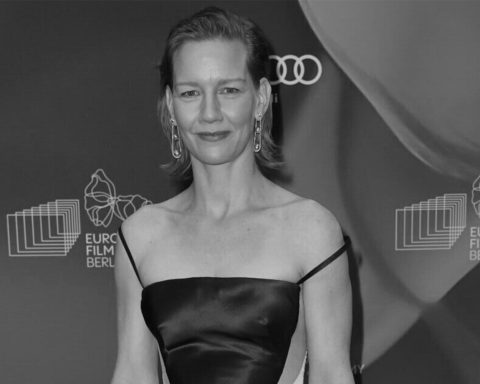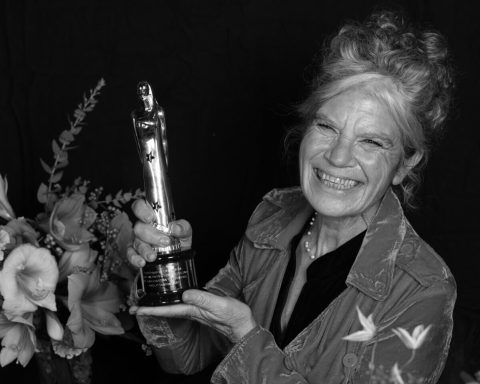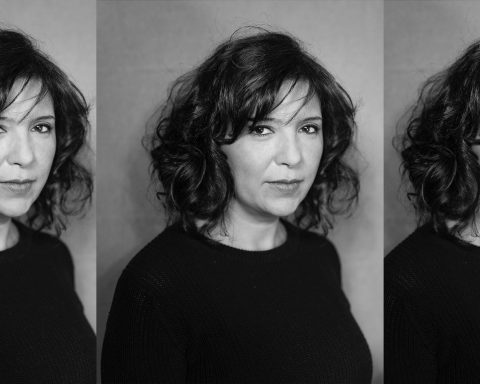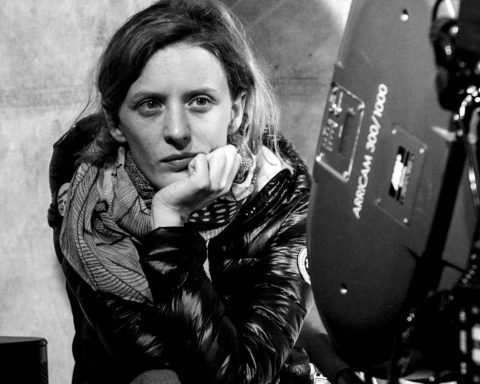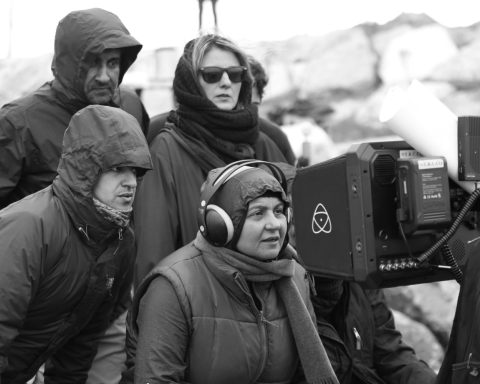At this year’s European Film Awards, Tara Karajica spoke with costume designer Charlotte Walter who was honored with the Excellence Award in Costume Design for her work on Kenneth Branagh’s “Belfast.” Her career so far, costumes in “Belfast” and working with Branagh on this particular project and women in film were some of the topics that were touched upon.
Have you always known you wanted to be a costume designer? How did you become one? How did you get into film?
Charlotte Walter: I didn’t always know that I wanted to be a costume designer because when I was really young, it wasn’t even a job that I knew was out there. I knew I wanted to do something within the design and art world. So I went to Art College. And then, I worked for the BBC in Birmingham and did work experience there and just realized that there was an amazing career to be had working within the costume department in TV and film.
You work in film, commercials, TV and editorial. Which one do you prefer? What is the difference in terms of the work process?
C.W.: They’re all very different. The work process is probably similar for film, for TV and commercials. Commercials are very fast and you work within the parameters of what a client wants, but it’s still really satisfying to create something in a fast environment. Film is lovely because you get to talk with the directors, producers, actors, about the story, and you get to create characters really. That’s what I love doing – to costume characters.
What triggers your creativity and what inspires you when you are working on a costume? How do you get in the zone? What is your work process?
C.W.: I read the script and imagine what the characters would look like. Then, I do research if it’s a period fill, and look at lots and lots of photographs of that period. I looked at many photographs of the late ‘60s for Belfast in Northern Ireland and there was an enormous amount of coverage. Lots of people took photographs of people on the streets, which was fantastically helpful. Also, looking at family photographs and photographs of my family just makes you remember what people wore in the late ‘60s and that it wasn’t all high fashion and London fashion particularly outside of London.
In your opinion, how does a costume help the director tell his/her story and complete the character? Do you fight for your vision?
C.W.: You don’t really fight for it. I think what you do is you imagine your character. You think of the style of clothes that you imagine they would wear; then, you wait to see the cast in that particular character. And then, it’s a matter of working with the actor and finding the character and making the actor feel comfortable within the clothes that they’re wearing and for them to realize that the character is appropriately dressed.
How did you get on board Belfast?
C.W.: It was quite a quick decision of Ken Branagh’s to make this film. He wrote it during the first lockdown. And so, Celia Duval, who was one of his producers and who I’d worked with before, phoned me and asked me if I was available and would also be alright to work during the COVID. It was the middle of the COVID pandemic; we were just coming out of the first lockdown that summer that we shot Belfast. So, I was really pleased to be asked; I thought it was wonderful script and came on board.
Can you talk about working on Belfast and working with Kenneth Branagh, especially as it is an autobiographical film. What was his input and vision in terms of costumes?
C.W.: It was great working with him. It was also lovely that it was his family we were recreating, which in one way was quite daunting because it was a very personal thing to him. He said that his Ma and Pa were an attractive couple, so that was a nice thing to recreate. He said his grandma and his mother had a lot of things hand-knitted. As like Buddy’s jumpers were hand-knitted as if they would have been hand-knitted by his mom. So, it was really satisfying to recreate his family and for him to look at them and imagine that they were properly represented, especially Buddy himself.
In terms of the costumes in Belfast, the looks are limited and the protagonists are working class people who are dressed very nicely. Can you talk about the colors, the textures and fabrics you used in your costume design for the film? How did you pick everything, knowing it was going to be a black and white film?
C.W.: At the very beginning, we weren’t one hundred percent sure that it was going to be black and white. And so, I picked the colors as if it was going to be in color. But I also chose textures that would shoot nicely and within black and whites and have some depth to them. And, it was important that the actors again felt right in their clothes. So, particularly for Ma, it was that her clothes were still in really nice colors. The little top that she wears quite a lot was a very soft pink. I just think it’s always important for actors to feel nice in their clothes, attractive and comfortable. And so, it was important to have nice colors, although eventually it wasn’t going to be seen, it didn’t matter. What mattered to me at that point was that the actors felt good in their clothes.
Talking about the actors, how much of a say do they have in the costumes when you’re creating their costumes and therefore their characters? If they do, to what extent?
C.W.: I think that that’s the most exciting part of my job. The first costume fitting that I have with an actor, where I’ve selected the clothes of my vision and the actor comes and starts to try them on and they say to me: “Oh, this is exactly how I would have imagined my character” and they get excited about it and then I get excited. It’s a lovely process!
How close do you work with the hair and make-up department when you are creating your costumes?
C.W.: Yes, we talk a lot. it helps to know if they’re going to change the color of the actress’s hair particularly with Catriona, Wakana [Yoshihara] put an amazing wig on her, which had more of a sort of red tinge to it. So that also helped me think of colors that would complement that hair coloring too. So, yes, it’s really important that you work together as a team.
Because Belfast is a period piece, how do you research a particular period for a costume? How important is historical accuracy for you? And, what is your opinion on the relationship between film and history in that sense?
C.W.: I think it’s important for period costumes to look authentic – as authentic as possible – but they also need to look appealing. It’s a difficult thing to explain; they need to look authentic, but not. Sometimes, you look at photographs of the period – if it’s sort of 20th Century – and to our contemporary eye, it doesn’t look very attractive. So, sometimes, you choose the clothes and shapes that are most attractive to the contemporary body and to the contemporary eye. So, for Belfast, particularly going back to Catriona and to Jamie, Ma and Pa, every single garment was an original 1969 garment, but I put it together in a way that they they looked real, but they also looked attractive because they were an attractive couple. They were a couple that went to the cinema a lot and I took their style and inspiration from movies of the time too, so they have an attractive edge to them.
What are the main faux pas in costume design in terms of fabrics, technique, etc.? What are the challenges?
C.W.: I think the challenge, if you’re doing period costumes, is to find the appropriate fabrics. It’s difficult now to find fads that would be similar to the ones of that time; the source is getting less and less and modern fabrics don’t always sit well. You have to choose your fabrics carefully. I think the important thing to do, if you’re making something, is to work with really clever people. And, I’m very lucky and very fortunate in as much as I have some very clever people that I work with that make beautifully the clothes, whether it’s making a dress or a corset or knitting a cardigan, they’re all incredibly skilled and talented and we recreate garments as they would have been recreated at the time.
Can you talk about the underrepresentation of costume design in the film industry?
C.W.: I think that sometimes people think: “Oh, they’re just clothes!” And, they’re not! They’re more than that! Every single garment is considered, every shape and color… And, in my opinion, it really does make a massive difference. And, I think that sometimes the best costumes are the ones that don’t stand out and aren’t showy on costumes as such, but they look like real clothes.
Who inspires you in your costume design?
C.W.: There’s lots of people who’ve inspired me over the years. In my day, when I was at Art College, the costume designer I loved was Shirley Russell. Later on, when I was a costume designer, I had the privilege of sitting next to her on the board of BAFTA and I said to her that she was the person that I really loved in when I was at Art College and she was so nice about it. But she said: “I didn’t know that these costumes are so amazing now twenty years later!” I was like: “Yes, they are still!” She has great taste and she made clothes that looked interesting, but real. Later on in my career, I was lucky enough to assist Milena Canonero. She’s amazing and she has a wonderful attitude to costume. I think that she’s one of my costume heroes. And, I was lucky enough at the beginning of this year to be asked to recreate some of her costumes for a Gucci ad campaign. It was really amazing for me to do to recreate Milena’s costumes for a Gucci ad campaign. The whole campaign was set around Stanley Kubrick films, so it was an honor to reproduce her costumes as near to how she’d made and created them herself.
Who is your favorite female filmmaker, and who would you like to work with that you haven’t worked with yet?
C.W.: That’s a really difficult one. It’s wonderful that female directors are now getting a chance to make films. There’s so many I would find it really difficult to say one. I think that it would be really exciting to work with a young female director who’s wanting to make films and is unknown. It’s always exciting to work with people who have a lot of creativity inside them and want to make films; not necessarily somebody who’s already established.
There has been a lot of talk with about women in film in the past five years. What is your take on it and how do you position yourself within this discussion? How is it in costume design now?
C.W.: I think it’s fantastic, but to be honest, I like working with men as much as I enjoy working with women. If somebody has true talent and is excited, for me, it doesn’t matter whether they’re a man or a woman. I think it’s great that women are now getting as much notoriety and also getting the chance to work in film, but for me I never felt that it was particularly a drawback being a female costume designer. When I first was a costume designer, the men were given jobs because for maybe the wrong reason, but because they were thought to be more reliable. I had very young children and I know there was an attitude when I was first a costume designer that maybe you’re not so reliable. If you’ve got young children, you probably will just go home if they’re ill. But thankfully now that’s not an attitude at all. In fact, people are encouraged to have a home life and that has changed and that is fantastic.
What film that you have worked on are you most proud of?
C.W.: Oh gosh! When I’m asked this question, it’s so hard to to answer. I’ve been so fortunate and worked on so many different types of films. I’m proud of lots of my work for lots of different reasons. I’m proud of doing films like Four Lions [by Christopher Morris] where I had a very, very small crew and very little money and it was exciting as much as working on a period film. I have a ton of favorite films; it’s very, very difficult because they are all different and I have attachment to all of them. From Michael Winterbottom’s Tristram Shandy: A Cock and Bull Story to the ones I’ve done recently – I loved doing Belfast; it was absolute joy! My whole team loved it. So, it’s really difficult as you can see. Every job is different and you work with different people, which is also really exciting!
What are your next projects?
C.W.: I am starting a movie in January.
This interview was conducted remotely at the 2022 European Film Awards.





